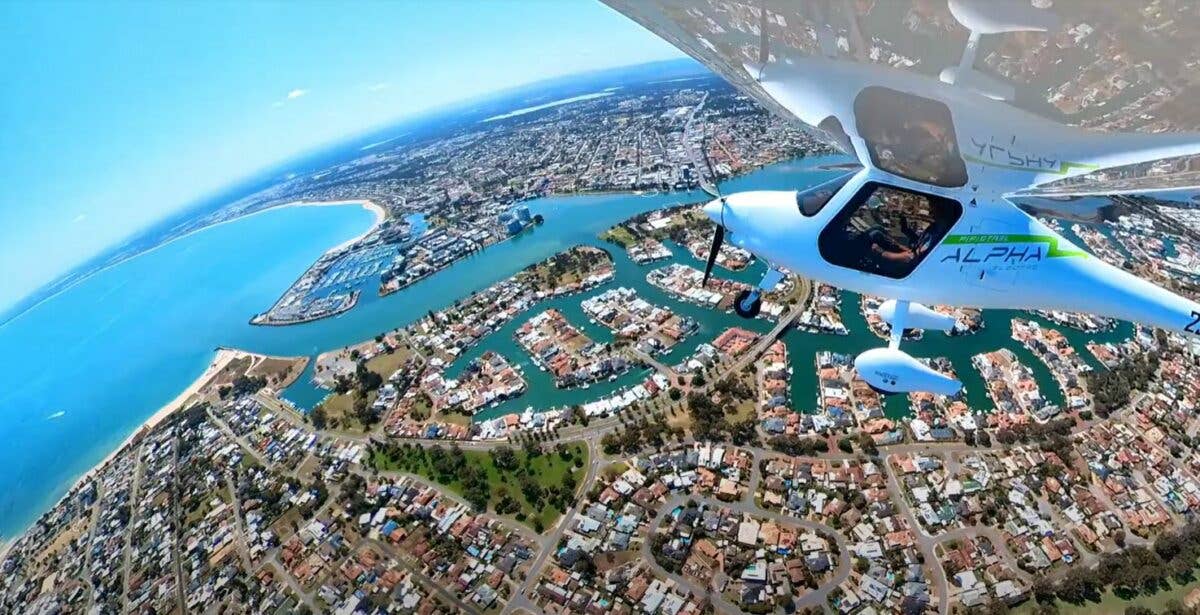FlyOnE Seeks To Electrify Australian Aviation
The start-up operates the first electric flight training aircraft on the continent, with expansion plans in the works.

The flyover by FlyOnE of Mandurah captured the promise of electric aviation in Australia. [FlyOnE video screenshot]
There’s no more avgas burning in Korum Ellis’ future—at least as far as he can help it.
The Australian entrepreneur founded FlyOnE with the express purpose of decarbonizing general aviation in the region, and he believes the answer lies in the implementation of electric aircraft.
FlyOnE is based at the Jandakot Airport (YPJT) south of Perth, in Western Australia. Jandakot serves as a busy reliever to the primary Perth International (YPPH). The start-up has collaborated with flight training organization Cloud Dancer Pilot Training at Jandakot to deliver the first recreational pilot course in electric-powered aircraft in Australia—and one of a handful now shepherding the new style of learning to fly worldwide—in a Pipistrel Alpha Electro.
Electric-Powered Training, Approved
In order to present a training syllabus in the Alpha Electro, the FTO needed approval from the Civil Aviation Authority of Australia (CASA). The signoff on the Alpha Electro to operate in Australia was secured nearly five years ago. “CASA has been amazingly supportive of electric aviation in Australia,” said a post on FlyOnE’s LinkedIn page, “and was one of the first governing bodies in the world to enable electric aviation with the first certificate of airworthiness issued for a Pipistrel Alpha Electro in 2018, with the help of Recreational Aviation Australia."
Approval of the integration of the airplane into a training syllabus came next.
With the lower cost of operation for the electric aircraft, Cloud Dancer offers that a prospective pilot could secure their recreational certificate—the initial one in Australia—for less than $10,000 (Australian) and in 20 to 30 hours of training.
“I want the electric aviation sector of aviation to grow and be effective but it’s not going to be quite as wild as some make it out to be,” said Ellis, referring to the prospect of completing an entire certificate using just electrics at this point.
The project overall has put 200 hours on the first Alpha Electro, with a second aircraft coming online in mid-February for training at Cloud Dancer. The chief instructor for the school, Adrian Van Schouwen, has 85 hours in the airplane giving dual—certainly more than anyone else in the country.
A large part of what FlyOnE and Cloud Dancer are proving is the viability of training in electric aircraft on a day-to-day basis in the real-world weather and airport conditions at Jandakot. They can fly 11.5 months out of the year, based on the VFR days in Perth, according to Ellis, with exceptions for when it’s too hot or windy to fly.
The wind limits are similar to those of any light sport or UL aircraft weighing 600 kg or less at max gross—the Alpha Electro’s limit is 570 kg—but the heat limitation has special nuances to it that are specific to the electric motor and the way the Alpha is designed. When the thermometer shoots to 40 degrees Celsius—as it can do easily in a Western Australian summer—the Alpha Electro reaches battery temperature limits quickly, particularly in the climb.
“We’re just learning so much about what we can and cannot do and how to get through the hot days,” said Ellis, “so when we do get to market with another aircraft, all our competitors will have to go through some pain in testing to discover that.” To this end, FlyOnE is seeking partners to join its Skycademy program along with Cloud Dancer.
First Electric Flight Over Sydney
An opportunity presented itself with the advent of Avalon 2023, the Australia international Airshow and Aerospace & Defence Exposition at Avalon Airport (YMAV) in Geelong, Victoria. Not held since 2019, the largest event of its kind on the continent offers a week of industry meetings and displays, as well as a long weekend open to the general public.
Because it is based in Perth, on the opposite end of a country nearly as broad as the U.S., FlyOnE saw a way to demonstrate the innovation already transpiring in alternative aviation powerplants and fuels by transporting one of the Alpha Electros used in training to go on display at the event. Ellis also secured the ability to make a demonstration flight over Sydney—a first for electric flight in the country’s largest metropolitan area.
On February 25, Ellis soared over Sydney’s Homebush Stadium and Olympic Park, demonstrating the first passenger aircraft powered by an electric motor in the area. While the current model won’t prove the ultimate trainer for the market, it represents a critical first step in proving the business case for electric aircraft and flight training globally.

Subscribe to Our Newsletter
Get the latest FLYING stories delivered directly to your inbox






